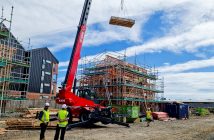The original Limitation Act 1950 covers the September earthquake claims and has a six-year limitation period from the event, so technically it runs out in September this year.
In December, all major insurance companies and EQC, with the support of the Insurance Council of New Zealand, announced that it would not claim the six-year limitation period as a defence under the Limitation Acts but all agreed to extend the period for one year to 4 September, 2017.
Most commercial earthquake claims have been finalised but a few are still pending.
Insurance companies are effectively facing additional obstacles and costs as EQC is still assessing properties that it now, after five years, deems overcap and, subsequently, these end up on the desks of insurance companies.
This means insurance companies are dealing with claims and claimants that have been in assessment or dispute with EQC for a long time. This is according to Belinda Barclay, a specialist corporate insurance claims manager with Crombie Lockwood in Christchurch.
The outstanding cases may require legal proceedings to force a settlement.
She advises business owners to be cognisant of looming deadlines that relate to the Limitation Acts.
The earthquake claims are covered by two separate Limitation Acts, one of 1950 and an amended version in 2010.
The original Limitation Act 1950 covers the September earthquake claims and has a six-year limitation period from the event, so technically it runs out in September this year.
EQC’s position is that it does not consider the six-year limitation period runs from the date of each Canterbury earthquake. However, it says that time limits can apply to bringing court proceedings challenging EQC claims’ settlements at some point after 4 September, 2016.
In summary, under both Limitation Acts EQC expects:
- Where an EQC claim has been settled, the six-year time limit for bringing court proceedings will run from the date EQC settled that claim;
- Where an EQC claim had not been settled, the six-year time period for bringing court proceedings will start running when EQC settles that claim;
- Where a claim is declined, the six-year limitation period will run from the date that EQC declines the claim.
In December, all major insurance companies and EQC, with the support of the Insurance Council of New Zealand, announced that it would not claim the six-year limitation period as a defence under the Limitation Acts but all agreed to extend the period for one year to 4 September, 2017.
“This has given claimants some breathing space but we would strongly recommend that all property owners with outstanding claims from the September quakes seek legal advice at the latest early next year, and consider lodging proceedings if deemed necessary before 4 September, 2017,” says Barclay.
“After the 2010 quakes, the government passed the new Limitation Act 2010 that covers all earthquake claims that arose from January 2011. Because it has not yet reached the six-year limitation period for the February quakes, there are no judicial directions on how this will be interpreted.
“One interpretation starts the limitation date from the moment a claim is made, while a different version favours the earthquake as the starting date. Again, with the sixth anniversary only one year away, we strongly suggest you seek legal advice.”
In this case however, it may be helpful to know that in some cases the insurance companies will cover legal costs as part of any settlement.
Many residents and business owners are reluctant to seek the legal route because they are loathe to pay legal fees. In this case however, it may be helpful to know that in some cases the insurance companies will cover legal costs as part of any settlement.
“That is also the case with some or all costs associated with engineering, geo-technical or quantity surveyor reports you may be required to incur yourself to obtain full information of all earthquake damage sustained to enable you to negotiate on a fully informed basis with the insurance companies,” adds Barclay.
“The landscape has changed dramatically since those first quakes and it is harder for residents dealing with claims at present. The initial claimants had more options, including the insurance companies managing repairs and rebuilds but these days many insurers prefer to cash-settle to clear their books.”
The Earthquake Court list at present is very long and ever increasing as more claimants find themselves in a stalemate with their insurance companies.
This includes complicated matters like multiple-unit claims, unit-title claims or businesses that have been sold to new owners but are still being settled.
One hurdle that many commercial negotiations are facing are multiple claims for several earthquake events on one property.
“Those claims have all become extremely complex since the Ridgecrest ruling in 2014 in which the Supreme Court ruled in favour of Ridgecrest, which was seeking damages arising from each event up to the limit of the sum insured,” points out Barclay.
Before that ruling, settlements were quite straightforward and businesses were paid out the fixed sum insured in most instances. The Ridgecrest ruling changed that and many claimants and their insurers are now trying to untangle the vexing issue of multiple claims and payment of multiple sums insured or part thereof.
“With a long list of claims waiting to go to court, new EQC claims going over cap and some businesses tied up in complex negotiations, we envisage the legal issues to occupy our courts for at least another five years, if not longer,” says Barclay.
“With that prospect, it will pay to keep an eye on the limitation deadline and not wait too long to get good legal advice.”
Vero is assisting all of its policyholders’ property claims from Christchurch earthquakes, regardless of the level of damage they have suffered, says Jimmy Higgins, Vero executive general manager of claims.
It assists with property claims whether over or under the EQC cap. “However, you will also need to lodge your claim with the EQC on 0800 326 243,” says Higgins.
“For damage to commercial property you will only need to lodge your claim with Vero.
“If your property has existing damage from a previous claim that is not yet finalised and has incurred new damage, then a new claim should be lodged with Vero and the EQC.
“If your property is under construction from a previous claim, Vero will be onsite to inspect your property within the next 72 hours to assess any dam




